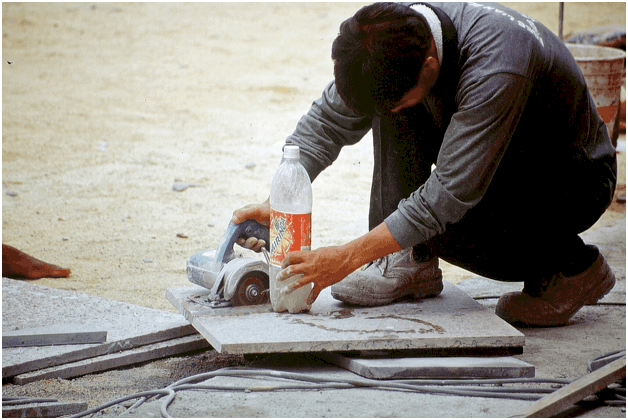
Before you look for some tile saw reviews to figure out which tile saw is best for you, it’s important that you have a decent understanding of wet tile saws vs. dry ones. As it turns out, you’ve got plenty of options when it comes to tools with which you can cut a tile. Many professionals like to go for a wet tile saw, which may lead you to think that this is the only option out there. However, depending on the particular situation, a dry one might make more sense.
Wet Tile Saws

Wet tile saws are round blades with tiny diamonds attached to them. This is industrial diamond and not the shiny kind you buy at your jewelers, so don’t worry about it getting stolen. The blade spins at a very high speed, and the diamonds cut through any tile material. You need some water to sprinkle over the tile constantly to cool the blade and the tile cool as the cutting happens.
When you’re dealing with extremely hard tiles, wet tile saws can be very useful and help you get the job done faster. They’re also pretty handy when you’re doing a larger job where many tiles are getting cut simultaneously.
The water is very important, especially when the blade is cutting through materials as hard as porcelain as it will prevent the blade from overheating, which might lead to excess friction and hinder the cutting efficiency of the blade.
Dry Tiles

Carbide Pencils
When you’re dealing with ceramic tiles or thin tiles of any material, it is possible to cut them with a special pencil tipped with carbide. The tip of the pencil will score the tile, and a line will be created. This line is a fault line along which the tile can be snapped into two. It is only useful for thin tiles and won’t work for hard, thick or dense tiles. There a wet tile would make more sense.
Tile Nippers
Wet tile saws are pretty useful for large jobs. However, for smaller jobs where dry cutting is appropriate, a tile nipper will do. A tile nipper is two blades connected to a handle. They are then squeezed together like you would the blades of a pair of pliers. This way, the nippers will take small bites out of the tile and are ideal for small jobs and jobs that require more attention to detail, such as mosaic tiles.
Score and Snap Tools
These tools are useful when cutting multiple thin and ceramic tiles. They don’t require the use of water, and they can do for much faster cutting. The tile is scored, and pressure is applied until it snaps. That way, many tiles can be cut very quickly. No friction is produced, so there is no need for water.
Conclusion

Whether you are in the middle of a kitchen makeover or just refreshing the look of your bathroom, new tiles can make the space a showplace. If you’re doing the work yourself, you’ll need a tile saw. All tiles can be cut with a wet saw. However, not all of them need a wet saw. The materials that would benefit the most from the use of a wet saw are porcelain, granite and marble. Glass tiles can also be cut with a wet saw provided the saw has a glass-cutting blade. Commercial-grade ceramic floor tiles can also be cut using a wet saw.
The post When to Use a Wet Tile Saw vs. Dry Saw appeared first on ThingsMenBuy.com.
from ThingsMenBuy.com https://www.thingsmenbuy.com/when-to-use-a-wet-tile-saw-vs-dry-saw/
via IFTTT